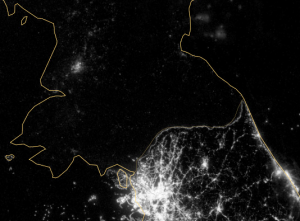North Korea Insights

This NASA photo shows the stark contrast between North and South Korea at night. Click on the photo to enlarge it and you will see that South Korea is gleaming with lights, especially in the sprawling capital of Seoul, but North Korea has hardly any lights at all—just a faint glimmer around its capital, Pyongyang. Two books I’ve read this month illuminated this dark world for me. In music teacher associations and English as a Second Language classes, I have known several Koreans, but never anyone from the North. Now I know why.
My first excursion to North Korea was The Orphan Master’s Son by Adam Johnson. This superbly crafted novel won the Pulitzer Prize for Fiction in 2012. It is a gritty read that makes horrible situations like starvation, sub-zero weather, interrogation and prison all too real–a vivid contrast to the cushy environment my new granddaughters and I were experiencing in Miami when I started it. Yet, even as I held these precious babies, I kept pondering how anyone could survive the challenges these characters faced. Many did not. Besides confronting knotty philosophical and political dilemmas, the protagonist has a doomed love affair. I had to laugh, though, when he sentimentally quotes the lyrics of “The Yellow Rose of Texas.” If Adam Johnson is as accurate in writing about North Korea as he is in describing a Texas barbecue attended by a North Korean delegation, then his work is completely convincing. This book demands another reading. Comment below if you are interested in discussing it.
My friend Carolyn recommended the perfect follow-on, Nothing to Envy: Ordinary Lives in North Korea. We now agree that this is one of the best books we’ve read in years. I just couldn’t stop turning pages. This non-fiction work won several prizes in 2010 for Barbara Demick, a journalist for the Los Angeles Times, who interviewed scores of defectors over the several years she worked in Seoul. She chose six people from the remote city of Chongjin who lived through the North Korea famine of the 1990s before they escaped to South Korea. Demick explains:
I focused on one city, Chongjin, so that I could confirm what people said with multiple witnesses. If one North Korean defector tells you about seeing bodies of children who starved to death on the street, you don’t necessarily believe them. But if there are dozens describing the same events at the same time, it adds up to a credible picture. Good reporting should have the same standard as in a courtroom — beyond a reasonable doubt.
Demick profiles an altruistic doctor, a reluctant entrepreneur, a crafty trader, a wily orphan, a frustrated Kindergarten teacher and a relatively privileged university student. The latter two conduct a sweet, chaste romance. Each character is brave and self-reliant; all feel guilty about the people they had to leave behind. Despite inadequate housing and clothing in freezing temperatures, desperate hunger, physical abuse and lifelong brainwashing, these people, unlike those in the novel, are able eventually to outwit the system. Such an account makes me grateful for every bite of food, every minute of electricity and every one of the human rights I enjoy.
To get a real sense of life inside North Korea, skip the photos of Dennis Rodman’s trip earlier this month to Pyongyang to celebrate Kim Jong Un’s birthday. Instead, watch the latest “Frontline” from PBS called “Secret State of North Korea.” It corroborates the insights in both books. Here’s the trailer, .
Leave a Reply